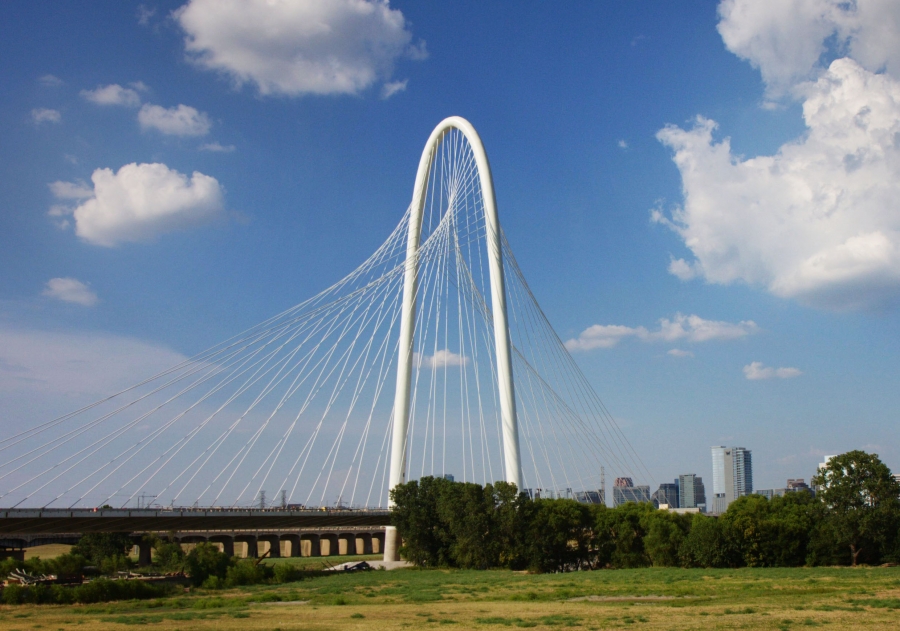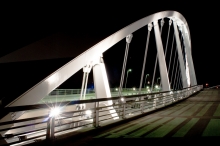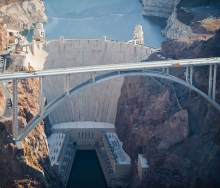Calatrava's Dallas: The Margaret Hunt Hill Bridge
Very much in keeping with Dallas' official “Live Large, Think Big” slogan comes a wonderful urban expression of the exuberance of this huge Texas city. The 400'-high Margaret Hunt Hill Bridge (MHH Bridge), designed by Santiago Calatrava, will span the Trinity River, connecting Dallas to West Dallas, and is expected to be complete in the spring of 2012, after 14 years of planning, design, budget cuts, redesign, and construction. The Trinity River Corridor Project, backed by a $245 million bond passed by Dallas voters in 2005, brought Calatrava to town to design three bridges over the Trinity River. Calatrava's bridges will provide an architectural signature for the Trinity River Corridor Project and hopefully will become a symbol of Dallas, nationally and internationally.
 Image licensed to R. Steven Rainwater under CC
Image licensed to R. Steven Rainwater under CC
Calatrava's Signature
The heirs to Margaret Hunt Hill's oil fortune supplemented the bond revenue with contributions to both design and construction funding to elevate what could have been a routine bridge design to something out of the ordinary: a single-stay cable bridge in Calatrava's signature white. Like all urban projects with striking design, the Margaret Hunt Hill Bridge has elicited public comments on both sides of the stockyard fence, from overwhelming support to wholesale dislike. Typical responses to the bridge's design and construction have included the usual mentions of the Eiffel Tower, which was wholeheartedly despised upon its construction, and the “wait until it’s done to be fair” rejoinders.
One constituency that seems likely to applaud the construction of the Margaret Hunt Hill Bridge is West Dallas, particularly La Bajada, a neighborhood at the bridge’s landing on the west end of the Trinity River. La Bajada is a historic Latino suburban community that is featured in City of Dallas plans as a district that needs to be protected and preserved. Its homes of Spanish-style stucco are festooned with ironworks and the yards abound with whimsical ornaments, creating a quirky, colorful expression of local culture. La Bajada benefits from some of the best views of the bright Dallas skyline, particularly as it’s reflected in the waters of the Trinity River, and it will now enjoy views of the Margaret Hunt Hill Bridge in the foreground. The Trinity River Corridor Project and West Dallas Urban Structure and Guidelines also call for the encouragement of the typical, trendy new-urbanist development, some of which is happening on its own, bringing an important and hopefully sustainable population to West Dallas, which has historically been Dallas’ repository for heavy industry and racial intolerance, along with its chemical and culturally toxic by-products.
Political Pressure
During the early stages of the bridge's design and construction (and true to Dallas’ conservative nature), powerful political practicality was brought to bear on the process, reducing greatness to goodness. Upon bidding the construction of the bridge, a significant variance between the estimate provided by Calatrava’s office and that provided by the general contractor’s office became evident, to the tune of over one and a half times the intended budget. The response, in what seems like classic Texas style, was to compromise, replacing a graceful seven-section arch with a simpler design and substituting round piers for graceful teardrop columns. This way of rectifying the problem was unlike the solution arrived at in Milwaukee, during Calatrava’s Quadracci Pavilion addition to the Milwaukee Art Museum, when the budget was adjusted upward to acknowledge and protect the inherent beauty of the design. Changes to the design of the Margaret Hunt Hill Bridge have taken their toll: the massive prominence of the central arch lacks the grace inherent in Calatrava’s original design, giving the bridge's arch a heaviness out of proportion to its latticed web of cable stays. A federal agency bias, which may have also enjoyed local support, came into play via a “Buy American” clause, which prevented the use of an Italian steel arch system previously used by Calatrava that was less expensive by 30% than the American product bid.
Dallas Looks to Boom in the Future
Dallas journalist Michael Ennis, in the August 2011 issue of "Texas Monthly," thoughtfully ponders: “After a decade in which Dallas’s population increase lagged far behind Texas’s other major cities’, some municipal soul-searching might be expected. But Dallas—which plans obsessively yet builds with don’t-fence-me-in abandon—has experienced similar flowerings of civic idealism before, only to see them wilt in the next boom cycle. Even the profound shocks of the Kennedy assassination and the eighties real estate bust, which led to interludes of introspection, hardly deflated Big D’s blustering egoism; few except hoary elders remember the sixties’ ‘Goals for Dallas’ or even the nineties’ ‘Dallas Plan.’ So will the [West Dallas Urban Structure and] guidelines join the dozens of past and present comprehensive city plans, land use plans, environmental study plans, and neighborhood revitalization plans eventually tossed into the dustbin of civic indifference? Or is it just possible that a city whose official slogan is ‘Live Large, Think Big’ is on the verge of fundamentally rethinking itself?”
Live Large, Think Big, and Build Beautiful
Ennis's questions have no easy answers. Likewise, will the compromises in the bridge’s design and its resulting reality be viewed in the long term as yet another lost opportunity and yet another work of prominent urban mediocrity, once again robbing Dallas of its place in the annals of great cities? In its fullest expression, the genius of artist, engineer, architect, and urbanist Santiago Calatrava’s work will be celebrated internationally for hundreds of years. Like the great Antoni Gaudi, the architect and engineer of the Sagrada Familia, one of the world’s most beautiful buildings and sacred spiritual places, Calatrava will gain an undeniable prominence in the world’s architectural history—but perhaps not so much because of this Big Texas bridge. In its next major urban endeavors (including Calatrava's other two bridges), Dallas might do well to add "Build Beautiful/Construir Bella" to its motto.

Morey Bean, AIA, LEED AP
Colorado's 1999 Architect of the Year and Vice Chair of the Boulder Chapter of the Urban Land Institute, Morey’s experience includes the successful development of the Colorado Architecture Partnership, an architecture firm dedicated to sustainability and green building. Morey was appointed by the Chief Architect of the GSA to the National Register of Peer Professionals. He serves as a ULI Service Advisory Panelist and was a charter member of the Colorado Chapter of the USGBC and past president of the Colorado South Chapter of the AIA. He is a construction litigation services expert witness, land development analyst and sustainability strategies consultant.
The author was honored by the Colorado Component of the American Institute of Architects as their Architect of the Year in 1999 and is on the Roster of Neutrals for the American Arbitration Association (AAA), providing dispute settlement for the design and construction industry.
Website: www.cyberarchitects.com


